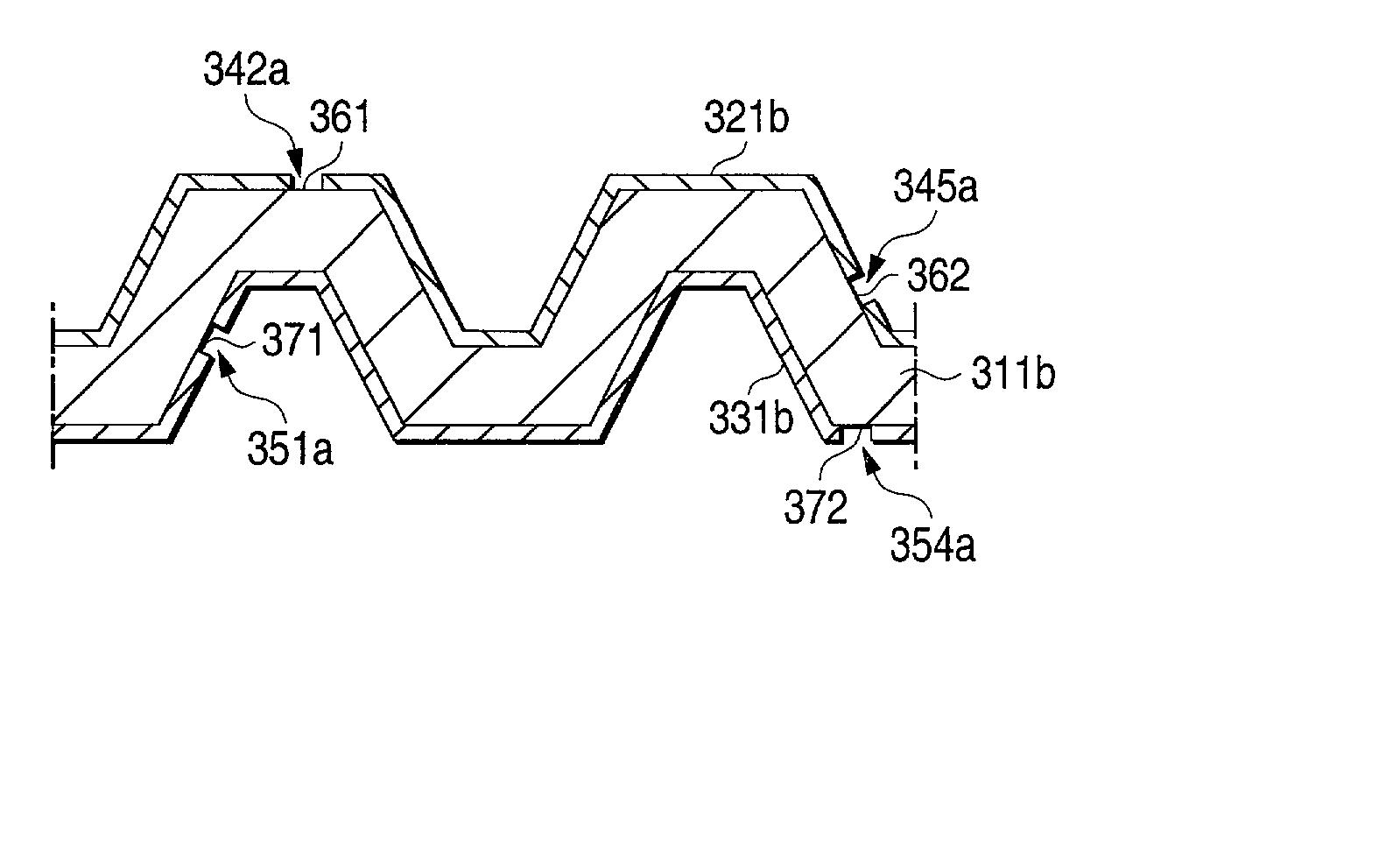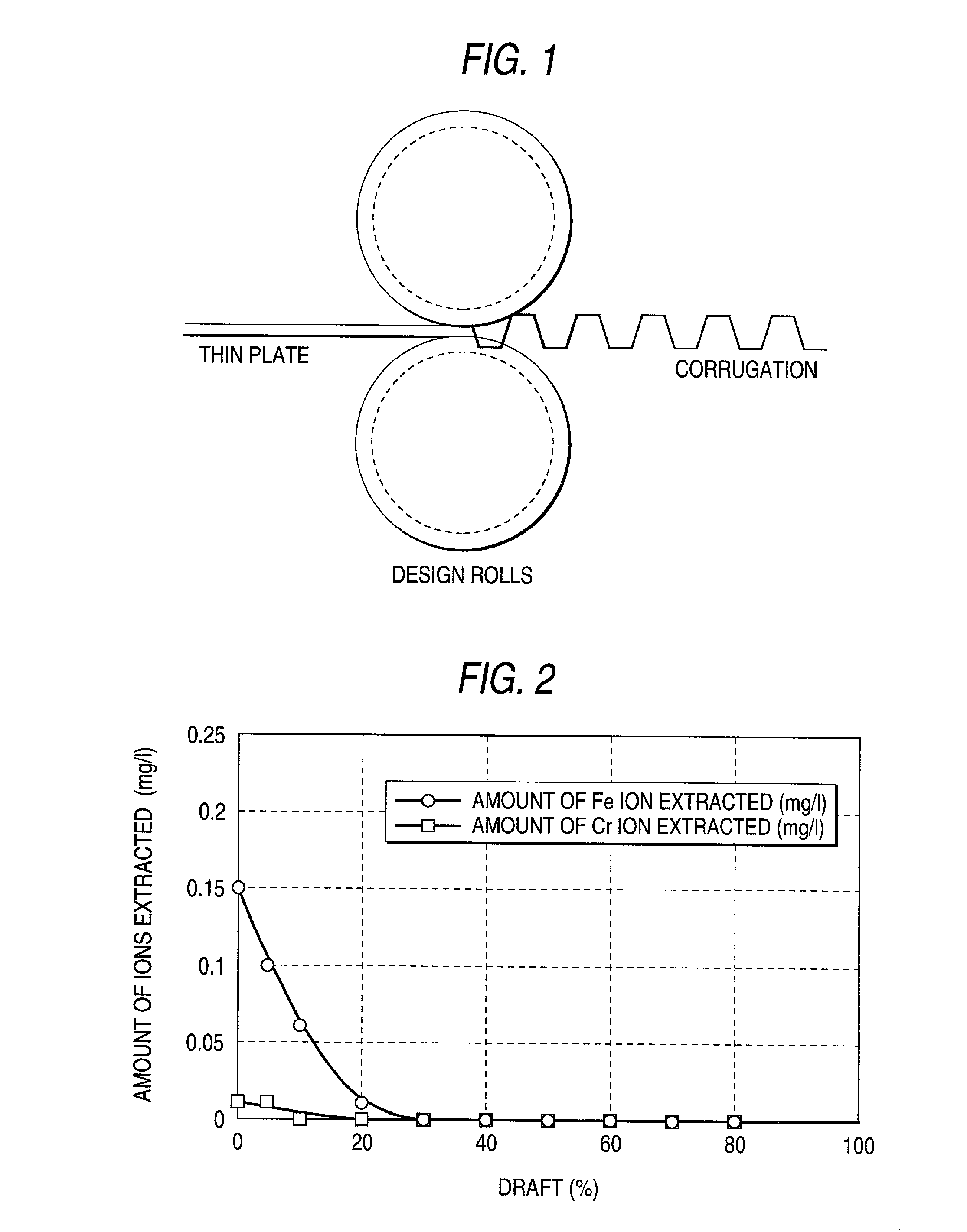Corrosion-resistant metallic member, metallic separator for fuel cell comprising the same, and process for production thereof
a technology of metallic separator and fuel cell, which is applied in the direction of sustainable manufacturing/processing, final product manufacture, electrochemical generators, etc., can solve the problems of poor adhesion to the base, poor corrosion resistance of the plated product thus obtained, and poor corrosion resistance of the deposit, so as to increase the amount of metal ions extracted, the effect of high corrosion resistan
- Summary
- Abstract
- Description
- Claims
- Application Information
AI Technical Summary
Benefits of technology
Problems solved by technology
Method used
Image
Examples
example 2
[0135] A coating film of a noble metal or alloy having the thickness shown in Table 2 was formed by electroplating on each side of an 80Ni-20Cr plate or pure-titanium plate each having a thickness of 0.3 mm. This metal plate and the coating film were rolled together at any of the drafts shown in Table 2 to clad the metal plate. Thus, samples having a noble-metal layer were produced as inventive samples and comparative samples. Test pieces for a hardness test, contact electrical resistance test, adhesion strength test, and corrosion resistance test were cut out of these samples in the same manner as in Example 1. The metal plates were examined for surface hardness. An adhesion strength test, contact electrical resistance test, and corrosion resistance test were conducted by the methods described above. The results obtained are shown in Table 2.
2 TABLE 2 Hard- Hard-Heat ness ness treat- before after Contact Metal plate Coating film ment heat heat electrical Thick- Thick- tem-treat- tr...
example 3
[0136] Inventive samples Nos. 6, 10, 14, 15, 19, and 20 obtained in Examples 1 and 2, which had been produced through cladding and had a noble-metal layer, were shaped by pressing to form grooves having a width of 2 mm and a depth of 1.0 mm with a pitch of 6 mm as shown in FIG. 5. Thus, metallic separators for polymer electrolyte fuel cells (PEFC) were produced which had dimensions of 32.times.32 mm. These metallic separators for polymer electrolyte fuel cells (PEFC) were used as test pieces to conduct a contact electrical resistance test and a corrosion resistance test by the following methods. The results obtained are shown in Table 3.
[0137] (1) Contact Electrical Resistance Test
[0138] A test piece of the metallic separator for polymer electrolyte fuel cells (PEFC), which had dimensions of 32.times.32 mm (effective contact area, 3.20 cm.sup.2), was sandwiched between carbon papers. A current of 100 mA (current density, 31 mA / cm.sup.2) was caused to flow through the sandwich under ...
example 4
[0141] Inventive sample No. 6 produced in Example 1 and inventive sample No. 14 produced in Example 2 were heated for 15 minutes at each of the heat treatment temperatures shown in Table 4 and then air-cooled to produce samples. Test pieces for a hardness test and corrosion resistance test were cut out of these samples. The metal plates were examined for surface hardness. A corrosion resistance test was conducted by the method used in Example 1. The results obtained are shown in Table 4 and FIG. 3
4 TABLE 4 Inventive sample No. 6 Inventive sample No. 14 Corrosion resistance test Corrosion resistance test Heat treatment Hardness after (ions extracted) Hardness after (ions extracted) temperature heat treatment (mg / L) heat treatment (mg / L) (.degree. C.) (HV) Fe Cr (HV) Ni Cr 25 266 <0.01 <0.01 255 <0.01 <0.01 100 265 <0.01 <0.01 257 <0.01 <0.01 200 267 <0.01 <0.01 255 <0.01 <0.01 300 260 <0.01 <0.01 254 <0.01 <0.01 400 259 0.01 <0.01 246 <0.01 <0.01 500 204 0.02 <0.01 199 0.01 <0.01 600...
PUM
| Property | Measurement | Unit |
|---|---|---|
| Fraction | aaaaa | aaaaa |
| Fraction | aaaaa | aaaaa |
| Thickness | aaaaa | aaaaa |
Abstract
Description
Claims
Application Information
 Login to View More
Login to View More - R&D Engineer
- R&D Manager
- IP Professional
- Industry Leading Data Capabilities
- Powerful AI technology
- Patent DNA Extraction
Browse by: Latest US Patents, China's latest patents, Technical Efficacy Thesaurus, Application Domain, Technology Topic, Popular Technical Reports.
© 2024 PatSnap. All rights reserved.Legal|Privacy policy|Modern Slavery Act Transparency Statement|Sitemap|About US| Contact US: help@patsnap.com










